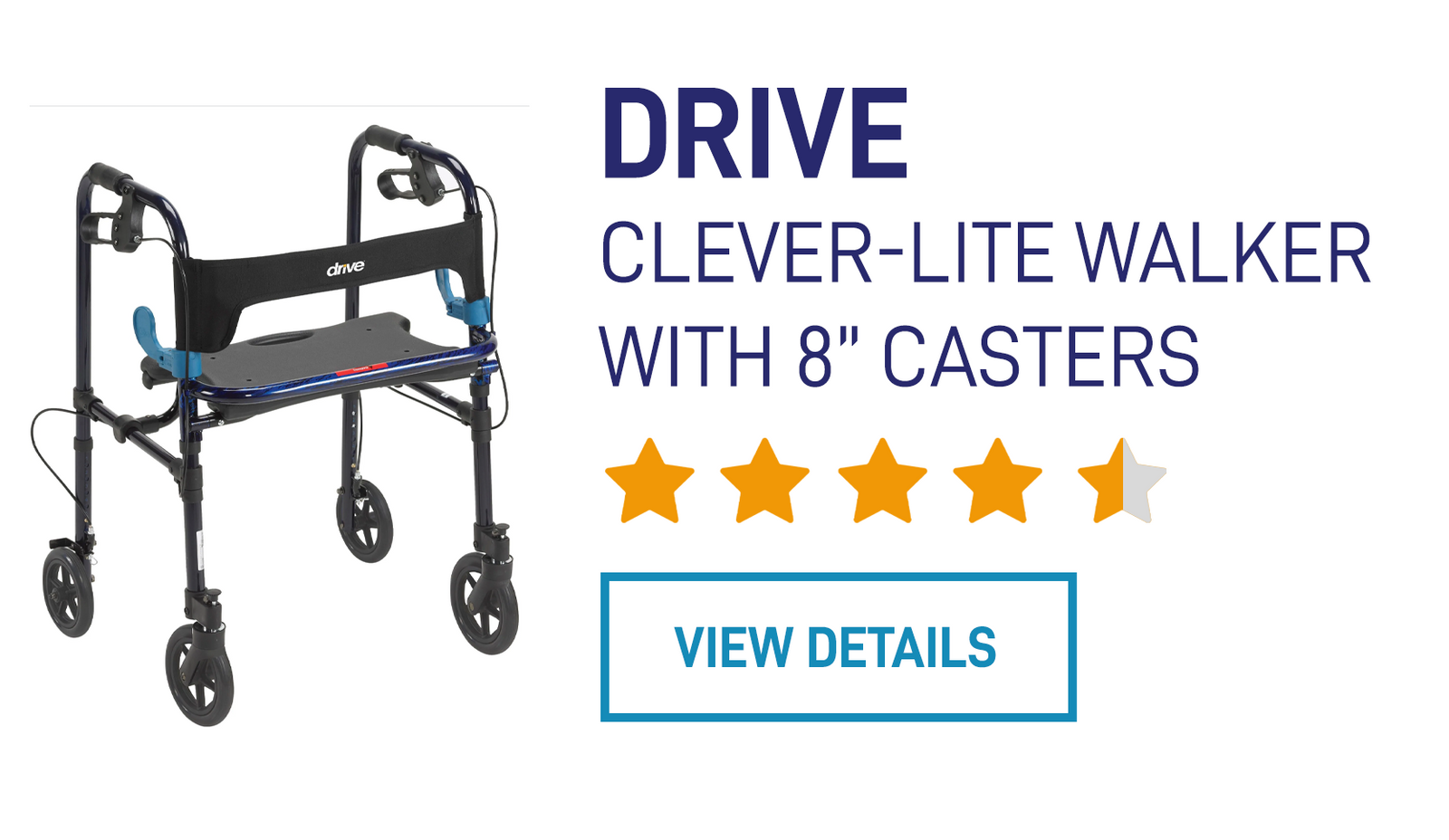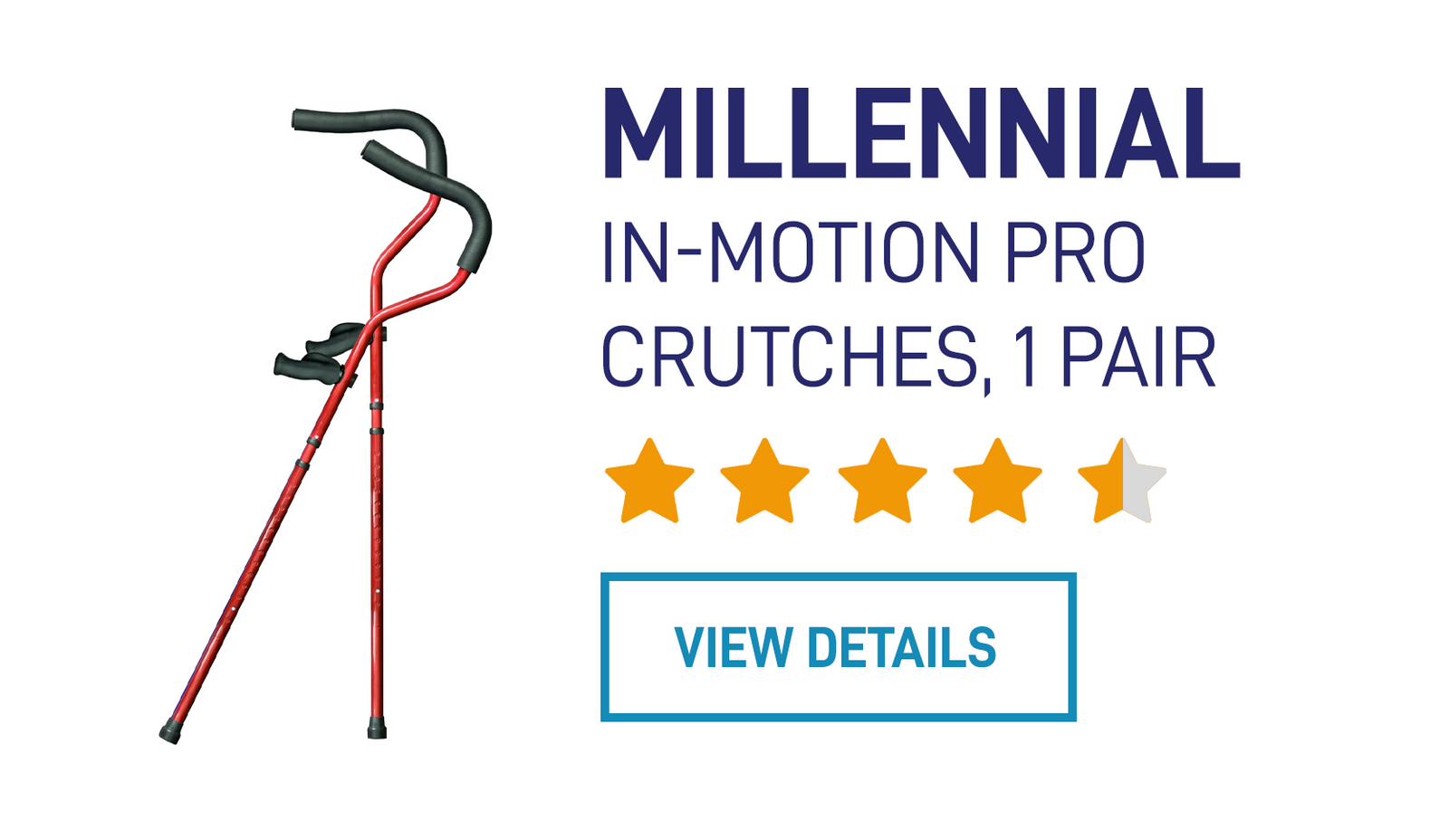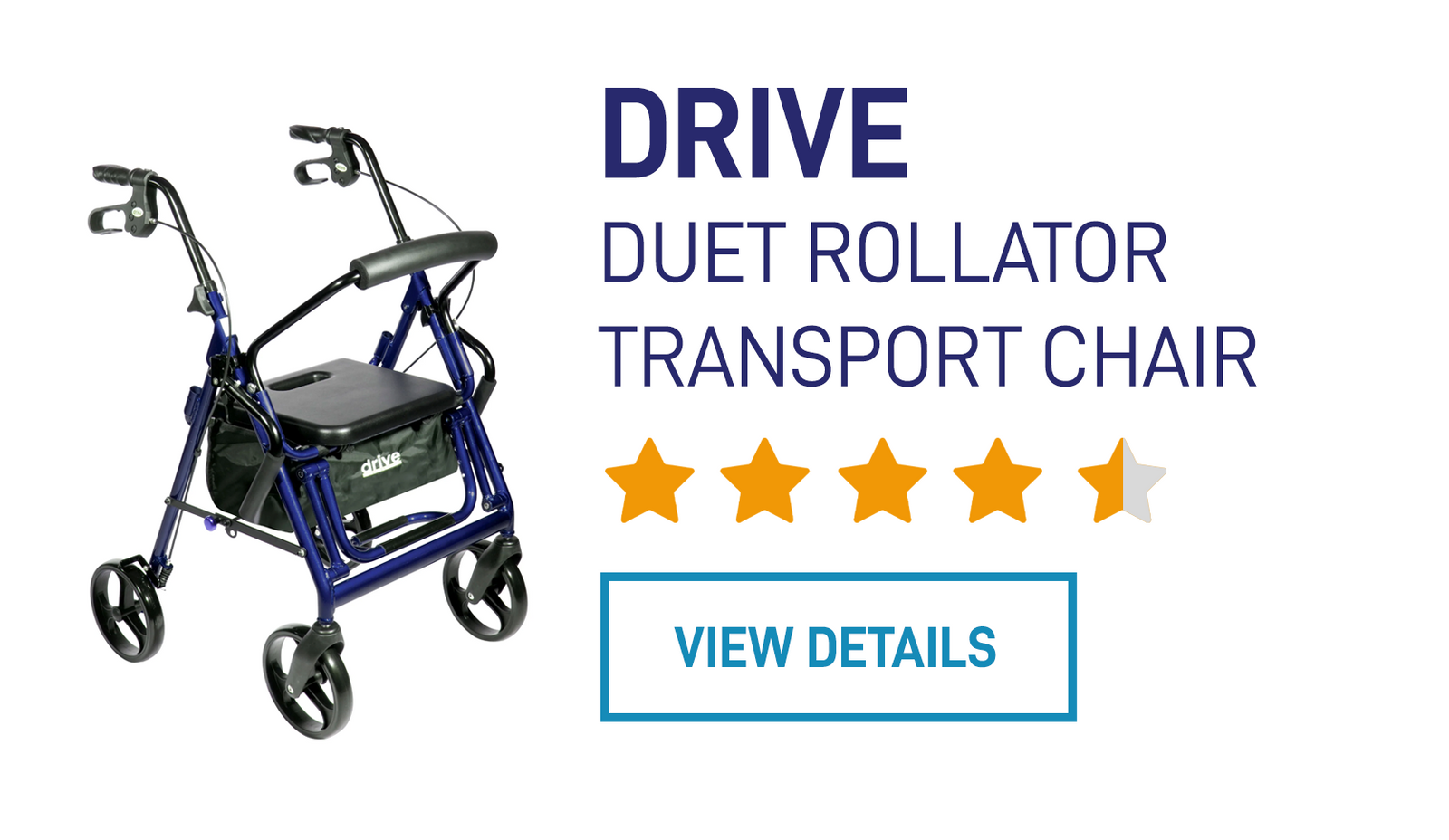Your Cart is Empty
Tips & Advice Center: Crutches Tips

Buyer's Guide to Crutches >>
Forearm Crutches vs Underarm Crutches >>
What are Crutch Alternatives? >>
How to Use Underarm Crutches >>
How to Use Forearm Crutches >>
Specialty Crutches >>
Knee Walkers >>
Ankle Surgery Recovery Tips >>
Any Further Questions? >>
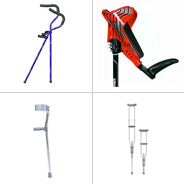
Buyer's Guide to Crutches
Those looking to buy their first pair of crutches may not be aware that there are two different types of crutches, and that they have some major differences. Underarm crutches, also called auxiliary crutches, are the most common type of crutch- these are the typical crutches assigned to patients in recovery from ankle or knee injuries. They have a pad that is held under the arm, pressed into the patient's side during use. The other major type of crutch is the forearm crutch, also known as the elbow crutch. These crutches have an open cuff that grips the user's forearm during use. The differences are not merely in design – the two different types of crutch have different strengths and weaknesses. Which type you choose should depend on your individual needs. Consider the following as you choose your crutches:
Strength – Crutches of all types require a certain amount of upper body strength for proper use. People often have the misconception that the arms alone hold the body's weight when on crutches. In fact, weight is distributed throughout the entire upper body, and the muscles of the trunk and shoulders do just as much work as the arms. Both underarm crutches and forearm crutches require upper body strength, though forearm crutches require a bit more from the user. If you have limited strength in your core, you may want to consider a knee walker instead.
Balance – Learning to walk on crutches can be a real challenge to balance and coordination. Underarm crutches are the most common type of crutch, and can be easier to master at first. However, forearm crutches are proven to give you greater control over your movement. They are often suggested for more active patients, as they allow different gaits for different terrain.
Fit – It is vitally important that crutches be properly fitted to the user. You should be able to stand up straight comfortably with a crutch, with your elbow bent between 15 and 30 degrees as your hand rests on the handle. Be sure your crutches are the right size for your body. Improperly fitted crutches can lead to abrasions, muscle pains, and nerve damage. Underarm crutches especially require proper fitting before use.
Crutch tips – Where crutches come in contact with the ground, they typically have a rubber, slip-resistant tip. These tips are very important, as they must support your weight and keep the entire crutch balanced as you walk. Larger tips have a wider surface area in contact with the ground, and provide greater stability. Some crutch tips articulate to make walking on your crutches easier and faster. Furthermore, some crutches feature special spring assist technology which allows the crutch to move with the user and adapt to their gait. Whatever type of crutch you use, be sure that the crutch tip is solid and unbroken.
Crutch handles – All crutches place a great deal of strain on the wrists and hands. To this end, some crutches feature special handles with extra padding, which can reduce stress and make your walking aid easier to grip. Others offer ergonomic shaping specific to the left or right hand. These offer greater security and comfort to the user. Be sure your crutch has a comfortable handle that will be easy for you to use over a long period of time.

Forearm Crutches vs Underarm Crutches
The two main types of crutches are forearm crutches, colloquially known as elbow crutches, and axial or underarm crutches, sometimes called armpit crutches. Though underarm crutches are the most well-known type, in many cases patients would be better off with forearm crutches. The two styles of crutch are very different, and cater to different types of users. When choosing between the two, there are several factors to consider.
- Strength – Both underarm and forearm crutches require upper body strength from the user. You will be supporting your weight with your arm, shoulder, and chest muscles. However, forearm crutches tend to require more strength in general. These are great for long-term users, who can build up the muscle mass and strength they need, but for the short term underarm crutches may be easier to use. If you have limited upper body strength, you will want to try underarm crutches.
- Posture – Posture is one very important factor to consider when choosing crutches. Many first-time users of underarm crutches tend to slouch over their crutches, and this can be a hard habit to break, eventually leading to strain and muscle pain. Forearm crutches, however, encourage good posture in their users- the taller and straighter a person stands, the easier their crutches will be to use. If you are worried about posture, you will want to try forearm crutches.
- Coordination – Underarm crutches are generally easy to master, as they have one basic possible gait. Forearm crutches can be more difficult to coordinate, and often require the consultation of a physical therapist to fully master. However, forearm crutches allow for a greater variety of walking styles and gaits, and are more stable on rough or uneven terrain. If you have trouble with balance and coordination, you will want to try underarm crutches. If you require more flexibility from your crutches, you will want forearm crutches.
- Comfort – Forearm crutches feature a cuff under the elbow which helps reduce strain and keeps some of the pressure off the wrist while in motion, making these crutches comfortable and easy to use. Underarm crutches, however, press against the side of the body when used, often leading to soreness and abrasions no matter how much padding they feature. If comfort is your main concern, you will want to try a pair of forearm crutches.
Whatever type of crutch you decide on, be sure it is properly sized and adjusted. Add a gel crutch pad cover or gel handle grip to reduce stress on your hands and sides, and be certain your crutch tip is a non-slip rubber in good condition.

What Are Crutch Alternatives?
Crutches are often prescribed as part of the recovery process for leg and ankle injuries. However, due to their size and their inconvenience, many crutch users find them impractical. Crutch alternatives are available to those who need them, though they are often under-publicized. Read below for a list of the best crutch alternatives available, as well as their various advantages.
- Knee Walkers – Knee walkers are fantastic crutch alternatives intended for use with injuries below the knee. These innovative devices completely eliminate all the normal strain and effort of carrying around a pair of crutches. Sometimes called knee scooters, a knee walker has a padded platform on which to rest the injured leg, a complete set of wheels, and some form of steering device for one or both hands. The Free Spirit Knee & Leg Walker even comes complete with a transmission steering system and a custom carry pouch. Be aware that knee walkers, like scooters, require constant attention, and need to be kept to low speeds.
- Forearm Crutches – Traditional crutches cause many hassles, including strain and abrasion from the jarring crutch pad. Forearm crutches offer a solution to this issue, completely removing the aspect of the crutch which jams it against your side. Millenial In-Motion Forearm Crutches are lightweight, strong, durable forearm crutches that hold on to your arm themselves, freeing up your hands for those times when you need them most. Forearm crutches are the only crutch alternative for those with hip or thigh injuries.
- iWALKFREE - The iWALKFREE Hands Free Crutch is a unique product that completely reinvents the entire idea of recuperation. Sturdy and compact, the iWALKFREE requires no hands at all to operate—simply strap it on, size it properly, and walk at a normal pace. The iWALKFREE allows the user to continue in many daily activities that might otherwise be off-limits or unfeasible. This hands-free crutch requires good balance from the user, and may take some time to get used to.
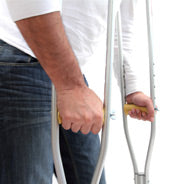
How to Use Underarm Crutches
Underarm crutches are the most common type of crutch. They require balance, dexterity, and a certain amount of upper body strength. It often takes some time and practice to master underarm crutches, but once you have it, you will never forget it.
- Adjust your crutches properly. Have a friend or family member help you for this step. Wear the shoes you plan to wear for most of your recovery and stand normally. The measurement should be made from an inch or two below your armpit to a point on the floor about two inches in front of your toes. This should be the height of the crutch. The crutch handgrips should be adjusted to allow for a 15 degree bend in the elbow when you are standing normally.
- Hold the crutches correctly. When properly used, your weight should be concentrated in your hands and on the crutch grips. Crutches should never jam into your armpits, nor should your shoulders be made to carry any weight.
- Standing on your uninjured foot, place the crutches a single step ahead of you.
- Lean forward onto the crutches, swinging your body forward. Always keep your injured foot off the ground.
- Let the crutches support your entire weight as you lift your uninjured foot and move it forward. Place it on the ground a step ahead of where your crutch tips rest.
- Repeat. With practice, you can achieve a smooth and steady motion that will propel you as quickly as your normal gait.

How to Use Forearm Crutches
Forearm crutches, also called elbow crutches, are usually prescribed to younger patients, but they can be beneficial for adults as well. Forearm crutches spread the burden of your weight across your entire forearm rather than concentrating it in your wrist – great for those with weak wrists or arthritis. They also encourage better posture and offer better support than underarm crutches.
- Adjust your crutches properly. Have a friend or family member help you for this step. Wear the shoes you plan to wear for most of your recovery and stand normally. To adjust the overall crutch height, flex your elbow so the crease of your wrist is level with your hips at a thirty degree angle. Measure from the largest part of your forearm to the floor, and adjust your crutch accordingly. The handle of the crutch should be level with your wrist.
- Put the crutch on so the open end of the cuff faces away from your body. Position the cuff one to two inches below your elbow, around the thickest part of your forearm. Grip the handles firmly.
- Place the crutch tips one step in front of you while standing on your uninjured foot.
- Let your forearms and crutches take your weight as you swing your body forward. Always keep your injured foot raised.
- Lift your uninjured foot and swing forward, carefully maintaining balance on the crutches. Place your foot one step ahead of the crutches and let your body's weight carry through.
- Repeat! With practice you will develop a smooth and even gait that allows you to move quickly in spite of your injury. You can also consult with a physical therapist for alternative gaits and rhythms.

Specialty Crutches
For many of us, when we think of crutches, all that comes to mind is the image of the standard aluminum armpit crutch. The truth, though, is that crutch technology has advanced a great deal since the days when the average crutch was little more than a crooked tree branch. Crutch manufacturers have expanded, creating a vast array of adaptations that fit the needs of any possible patient. Whatever you are looking for, there is a specialty crutch out there designed for you.
Millennial Medical crutches are specially designed to fit into a busy lifestyle. They offer both underarm crutches and forearm crutches for longer-term use. Millennial crutches are streamlined, attractive walking aids that fold for easy storage and transport. But these folding crutches have one more advantage over standard crutches - a specially designed spring assist tip that absorbs shock and reduces stress. Spring assist crutches offer a power assist each time your crutch touches the ground, making walking easier and less tiring. They also absorb shock, preventing uncomfortable jarring to your side and arms.
The iWALKFREE is a hands-free crutch that can make life much easier for those who are required to stay off a foot or ankle. This revolutionary crutch allows a user to walk with both hands free for use. It is a small device that makes it much easier to navigate crowded spaces or small aisles. Though it may be difficult to master at first, the iWALKFREE can be a huge improvement over traditional crutches in mobility and independence.
From the Millennial Crutch with its spring assist tip to the hands-free crutch, there are far more crutches out there on the market than most people are aware of. If you're unhappy or uncomfortable with your standard hospital crutches, you should definitely check out the array of specialty crutches available to you – you might just find something that makes your life a lot easier!

Knee Walkers
Knee walkers, also known as knee scooters or rolleraids, are specialized walkers that function as crutch alternatives. These mobility aids are small, steerable, non-motorized scooters which take all the weight off one foot and allow you to move about freely. Knee walkers are portable and easy to use, making them great for long periods of recuperation and recovery. They let the user stand with both hands free for other tasks, while crutches require attention and can be difficult to deal with. And while most crutches are bulky and hard to store, knee walkers like the Economy Knee Walker fold conveniently and tuck away behind car seats or under tables.
Traditional crutches are heavy and occupy both hands during use. Being cheap and easy to find, they are often prescribed to people recovering from an ankle injury or a foot injury. Many find that after only a few days of use, their crutches have become completely intolerable – and they still have to stay off the injured leg for weeks! What started out as a simple foot injury can lead to a lot of aggravation.
In cases like these, or for those recovering from ankle surgery, a knee walker is an ideal solution. Knee walkers take all the weight off the foot, transferring it instead to the knee and shin. This frees up the injured foot while allowing the patient to get around freely.
People being treated for serious conditions need to be especially careful – these injuries get infected easily, and the risks and costs associated with treatment skyrocket fast. For these patients, staying off the foot is no mere recommendation, but a matter of continued health and safety. Unfortunately, the size and inconvenience of crutches do not make them easy to use. While it is often tempting to skip crutches for short walks or errands, patients recovering from diabetic foot ulcers or Achilles tendon ruptures cannot afford these temptations. For them, the ease of a knee walker makes it far more likely that proper recovery procedures are followed.
For some first-time users of knee walkers, balance may be an issue. Luckily, many knee walkers are designed for maximum security and comfort during use. The contoured, oversized cushion of the Knee Cruiser ensures that any user will stay easily centered on the pad without slipping off. Others may have trouble with steering or control. In these cases, a knee walker with a transmission steering system will help them immeasurably. For any special circumstance, there is a knee walker out there designed to fill the need.

Ankle Surgery Recovery Tips
Ankle surgery is a necessary evil for many people at some point in their lives, but most don't realize that the hardest part comes later, when they are at home and in recovery. An ankle that can't bear weight is an ankle that can't run to the next room to retrieve something, or stand in front of the stove cooking a meal, or carry clean laundry up from the dryer. The medical procedure may be over, but recovering from ankle surgery is a long and hard journey. Fortunately, there are several steps you can take to make recovery simpler and less inconvenient to your daily life.
- Get Good Crutches – The standard crutches sold by hospitals or handed out by insurance companies are usually the cheapest available. They'll do the job, but they all too often have insufficient padding, leading to sore hands and abrasions. Crutches with thick, resilient padding and ergonomic handgrips can make recovery a far more pleasant process, and will not lead to any secondary injuries. Also, the more comfortable your crutches are, the more likely you are to use them, speeding your recovery.
- Try Folding Crutches – Carrying standard underarm crutches around wherever you go can be a real hassle, and storing them in crowded restaurants or on busy trains can cause no end of problems. But folding crutches eliminate that issue completely, collapsing down to a compact bundle easy to keep under a chair or table. Millennial In-Motion Pro Crutches are adult forearm crutches that fold in half to a fraction the size of traditional crutches, so that they can take you wherever you need to go.
- Use a Knee Walker – Knee walkers are fantastic alternatives to crutches. These ingenious devices take all the pressure off your ankle without sacrificing balance, mobility, or dexterity. They cause no abrasions, require little upper body strength, and fold away for convenient storage. The Free Spirit Knee and Leg Walker even comes with a transmission steering system for greater agility and maneuverability.
No matter if you are in recovery for one week or twenty, your recuperation period will be far easier if you trade in your standard crutches for something smaller, comfier, and easier to use.

Any Further Questions?
If you didn't find the answer you were looking for, feel free to call us toll-free at 1-888-986-0660. Our highly-trained staff is waiting to hear from you every weekday from 8:00 AM to 6:00 EST. You can also email us through the form found here.


